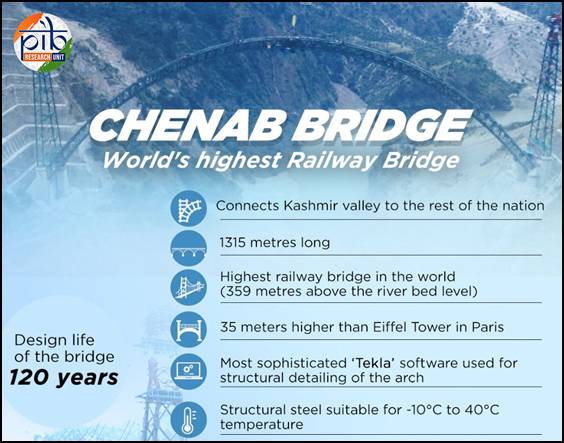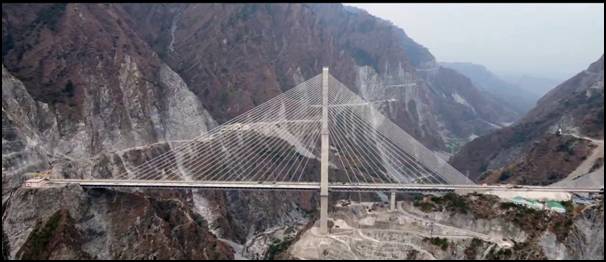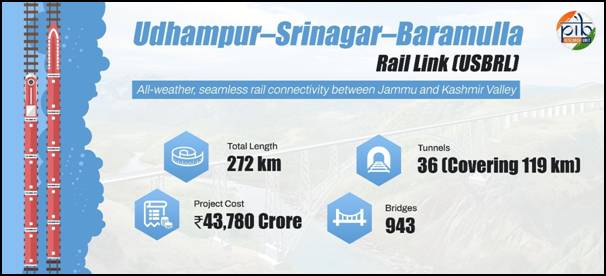Infrastructure
Rail Renaissance in Jammu and Kashmir
11 Years of Expanding Access, Mobility and Opportunity
Posted On: 04 JUN 2025 6:18PM
Introduction
The Vande Bharat Express is set to glide swiftly between Katra and Srinagar, cutting down travel time and setting a new benchmark in comfort for the people of Jammu and Kashmir. This development is more than just a new train service. It stands as a symbol of how far the region’s railway network has come over the last 11 years.
On 6thJune, Prime Minister Narendra Modi will visit Jammu and Kashmir to mark this progress. He will flag off new Vande Bharat trains and inaugurate two engineering marvels: the world’s highest railway bridge over the Chenab and India’s first cable stayed rail bridge at Anji.
The rail map of Jammu and Kashmir has been redrawn with precision and purpose. Projects once seen as distant dreams have become functional links connecting lives, livelihoods and landscapes. With full electrification, a dedicated railway division, and station modernisation underway, the region is now firmly on track for faster, cleaner, and more inclusive growth.
Chenab Rail Bridge
Towering 359 metres above the riverbed, the Chenab Rail Bridge stands as the world’s highest railway arch bridge. It rises 35 metres higher than the Eiffel Tower. Spanning 1,315 metres, this steel arch structure is a key part of the Udhampur Srinagar Baramulla Railway Link and marks a significant milestone in Indian engineering.
Designed to endure harsh terrain and extreme weather, the bridge can withstand wind speeds of up to 260 kilometres per hour and is built to last 120 years. With a project cost of ₹1,486 crore, it is not just a bridge but a symbol of India’s technical prowess. Structural steel suitable for temperatures ranging from minus 10 to 40 degrees Celsius has been used, ensuring resilience across seasonal extremes. The most sophisticated ‘Tekla’ software was used for structural detailing, enabling high precision in design and execution.

A key impact of the bridge will be in enhancing connectivity between Jammu and Srinagar. With the Vande Bharat Express running over it, travel time between Katra and Srinagar will come down to just about three hours, reducing the existing journey by two to three hours.
Anji Khad Bridge
The Anji Khad Bridge rises boldly across the rugged Himalayan terrain, standing as India’s first cable stayed railway bridge. It spans the deep Anji River valley, south of the Chenab, connecting the Katra Banihal section of the Udhampur Srinagar Baramulla Rail Line.

About 80 kilometres from Jammu city, the bridge is set against a striking backdrop of snow-covered peaks. Towering 331 metres above the riverbed and stretching 725 metres across, it is anchored by 96 high tensile cables. At its heart stands an inverted Y shaped pylon that climbs 193 metres above its foundation. The total length of cable strand used in the bridge is an impressive 653 kilometres. Remarkably, the entire structure was completed in just 11 months.
Over 8,200 metric tonnes of structural steel have gone into its construction, ensuring strength and durability in a region shaped by young, restless mountains. Built to endure tremors, strong winds and shifting geology, the Anji Khad Bridge is more than an engineering feat. It is a symbol of human will and vision.As part of the Udhampur Srinagar Baramulla Rail Link, it promises to bring smoother travel, faster transit and greater economic opportunities to the region.
USBRL and Vande Bharat Trains
The Udhampur–Srinagar–Baramulla Rail Link (USBRL) is one of the most ambitious railway projects undertaken in independent India. Stretching 272 kilometres through the rugged Himalayas, the project has been built at a cost of ₹43,780 crore. It includes 36 tunnels that span 119 kilometres and 943 bridges that knit together valleys, ridges and mountain passes. Designed to overcome the region’s challenging geography, it connects remote areas to the national rail network and marks a new chapter in mobility, trade and tourism for Jammu and Kashmir.

To maximise the impact of this connectivity, the Vande Bharat Express is being introduced between Jammu and Srinagar. Unlike other trains of its kind, this one is tailored for the harsh Himalayan winters. It runs smoothly even in temperatures as low as minus 20 degrees Celsius. Heated windshields, advanced heating systems and insulated toilets ensure that the train remains operational and comfortable throughout the year.
Supporting this route is a snow removal train that moves ahead to clear the tracks, ensuring year-round services. Seismic dampers have also been installed to absorb tremors, offering a safer and smoother journey in this high-risk zone. Together, these efforts are reshaping public transport in Jammu and Kashmir, making it more resilient, reliable and future-ready.
Other Key Initiatives
Over the past 11 years, the government has taken consistent and focused steps to strengthen railway infrastructure across Jammu and Kashmir. From expanding pilgrimage routes and building world-class stations to commissioning new lines and introducing electric trains, each effort has brought tangible benefits to the region. Strategic projects such as the T-50 tunnel, the creation of a dedicated railway division, and full track electrification reflect a deeper commitment to lasting connectivity, economic growth, and inclusive development.
Katra Rail Link Boosts Connectivity and Pilgrimage (July 2014)
Commissioned in 2014, the 25.6 km Udhampur–Shri Mata Vaishno Devi Katra rail section, built at a cost of ₹1,132.75 crore, marked a key milestone in Jammu and Kashmir’s rail expansion. Part of the Udhampur–Srinagar–Baramulla Rail Link (USBRL), it features 10.9 km of tunnels, 36 bridges, and a modernised Katra station. Also, 700 landowners from whom more than 75% of their land was acquired for this project have been given permanent jobs in the Railways.
Construction of Shri Mata Vaishno Devi Katra Station (July 2014)
Inaugurated on July 4, 2014, Shri Mata Vaishno Devi Katra station is a modern four-line crossing station equipped with a range of passenger friendly amenities. Platforms 1, 2 and 3 are the main passenger platforms, each 550 metres long and covered by 400 metres of high-level shelters.
The station is well equipped with water booths, public conveniences, water taps, benches and other essential facilities across all platforms. A dedicated foot over bridge has also been constructed to provide seamless access for local residents of the town.
Shri Shakti AC Superfast Express (July 2014)
Flagged off by Prime Minister Narendra Modi on July 4, 2014, the Shri Shakti AC Superfast Express (22461/22462) connects New Delhi with Shri Mata Vaishno Devi Katra station. The launch coincided with the commissioning of the 25-km Udhampur–Katra rail line, enhancing pilgrim access to the revered shrine.
New Rail Lines and First Electric Train in Kashmir Valley (Feb 2024)
In Feb 2024, a new 48-km rail line between Banihal, Khari, Sumber, and Sangaldan was commissioned, along with the newly electrified 185.66-km Baramulla–Srinagar–Banihal–Sangaldan section. Prime Minister Narendra Modi flagged off the valley’s first electric train and also launched train services between Sangaldan and Baramulla stations. The Banihal–Sangaldan section features Ballast less Track (BLT), ensuring a smoother and more comfortable ride for passengers.
Banihal–Katra Section Nears Completion (Jan 2025)
In January 2025, final safety inspections began on the 111 km Banihal–Katra section of the Jammu division, paving the way for full train connectivity between Jammu and the Kashmir Valley. The section features 97 km of tunnels and 4 major bridges spanning 7 km. Meanwhile, Jammu station is being redeveloped with 8 platforms and modern facilities to offer a world-class travel experience.
Creation of Jammu Railway Division (Jan 2025)
In January 2025, Indian Railways inaugurated the new Jammu Railway Division under Northern Railway, with its headquarters in Jammu city. Launched by Prime Minister Narendra Modi on January 6, this division was carved out of the Ferozepur Division to better serve the rail transport needs of Jammu and Kashmir, Ladakh, Himachal Pradesh, and parts of Punjab. The division includes 11 key goods terminals, facilitating the movement of food grains, cement, coal, fuel, and perishable produce across the region.
T-50 Tunnel and Road Connectivity under USBRL Project
Tunnel T50, measuring 12.77 kilometres, connects Khari and Sumber in Jammu and Kashmir. It is the longest transportation tunnel in the country and the longest one built under the Udhampur–Srinagar–Baramulla Rail Link (USBRL) project. This tunnel has become a key link in ensuring uninterrupted rail connectivity between the Kashmir Valley and the rest of India.
Constructed using the New Austrian Tunnelling Method, the tunnel passes through complex and varied geology including quartzite, gneiss and phyllite. The route faced major construction hurdles such as high-water ingress, landslides, shear zones and jointed volcanic rock formations. To meet these challenges, engineers built three adits(access tunnels) that allowed work to begin from multiple faces at once, which helped accelerate the construction timeline. The design includes a main tunnel and a parallel escape tunnel, connected through cross-passages every 375 metres to ensure safety.
Tunnel T50 is fully equipped with CCTV cameras installed every 50 metres. All feeds are monitored from a central control room to support safety and smooth operations. In addition, Indian Railways constructed 215 kilometres of approach roads to provide access to project sites, improving transport and connectivity for nearby communities.
Complete Railway Electrification in Jammu and Kashmir
Jammu and Kashmir achieved 100% electrification of its railway tracks, marking a significant step towards more efficient and sustainable rail transport in the region.
Amrit Bharat Station Scheme in Jammu & Kashmir
Under the Amrit Bharat Station Scheme, the Ministry of Railways has undertaken the redevelopment of four stations in Jammu and Kashmir—Budgam, Jammu Tawi, Shri Mata Vaishno Devi Katra, and Udhampur—with a focus on modern facilities, improved passenger experience, and integrated urban development.
Railway Allocation for J&K in Union Budget 2025-26
In the Union Budget 2025-26, Jammu and Kashmir received an allocation of ₹844 crore for railway development, aimed at accelerating ongoing projects and enhancing rail infrastructure across the region.
Conclusion
Over the last 11 years, the government has reshaped the railway landscape of Jammu and Kashmir with vision and resolve. From engineering marvels like the Chenab and Anji Khad bridges to all-weather connectivity through the USBRL and Vande Bharat trains, each step has brought the region closer to the rest of the country. Complete electrification, upgraded stations, and focused budget support have further strengthened this momentum. What was once an isolated terrain now pulses with the rhythm of modern infrastructure, opening new paths for growth, trade and tourism.
References:
Click here to download PDF
****
Santosh Kumar/ Sarla Meena/ Saurabh Kalia
(Backgrounder ID: 154553)
Visitor Counter : 1962